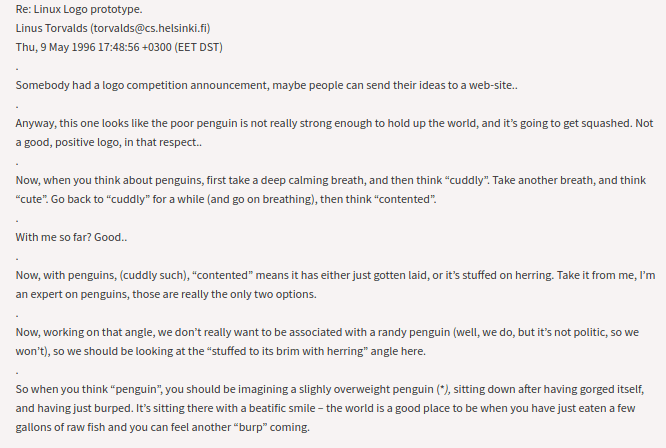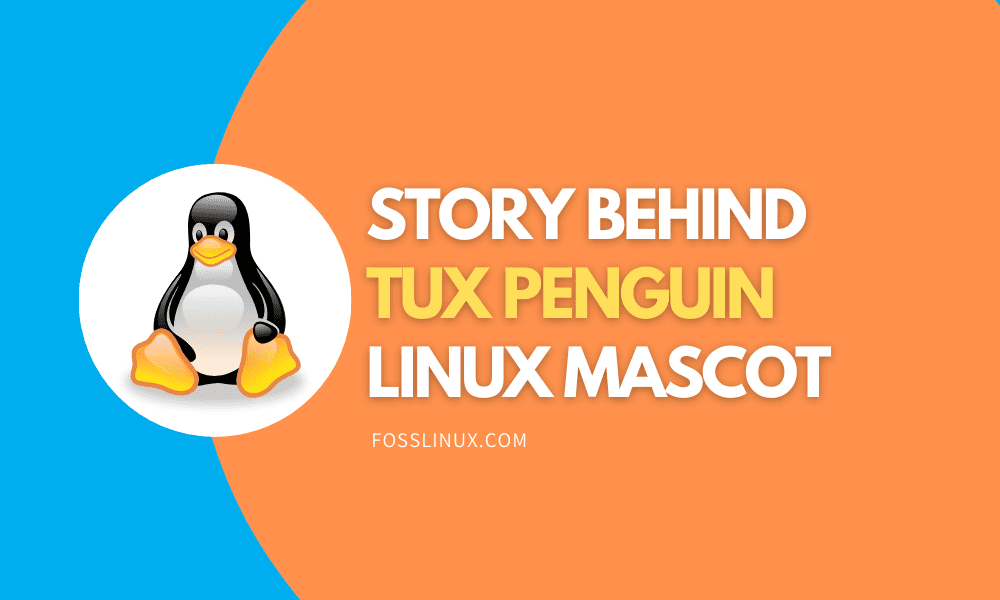We cannot 100% declare ourselves as complete Linux users or enthusiasts without having boarded the same train with the famed official Linux Mascot, Tux Penguin. There is more to why Linux chose Tux Penguin as its brand ambassador other than the fact that a Penguin has a big head and can adapt to the survival of inhumanely cold weather.
We can relate the size of its head to the numerous adaptive commands they share with the Linux operating system. The Penguin’s adaptation to extremely uncomfortable weather is evident in the Linux operating system’s endurance.
Other than these correlations that we just brewed from the North Pole, only Linus Torvalds, the name behind the creation and development of the Linux kernel, settled this debate. His casual declaration of Tux Penguin, in May 1996, as the winner of the Linux Mascot debate was due to his fondness of these cute, composed, and flightless birds.
Since Tux Linux became an official icon for the Linux operating system, it has been styled and presented differently by the existing vast varieties of Linux distributions. Also, it is not only the Linux architecture that employs its usage but also a variety of Linux programs and gaming platforms. These few texts we have digested are not enough to quench the thirst behind the Tux Penguin’s existence. To get a clearer picture and understanding of what brought this Linux Mascot to life, we have to take a historical journey from where it all began.
Tux Penguin Origin
The archives of the early Linux days best depict this story. The Linux development team was making bold steps in its developmental improvement. They had foreseen the potential impact the operating system was going to have on the world around us. It was only fair for the Linux operating system to have a brand representation that would accompany its launch. To get the best out of this creation, they launched a Linux logo competition with interested participants from all walks of life.
Tux Linux did not just pop up as the undisputed winner as there were some interesting contributions from other participants who wanted a fair share of this fame that would associate them with creating the official Linux logo. Interesting contributions involved animals like sharks and eagles to create the Linux logo. The competitors in creating the official Linux logo also engaged in interesting arguments to defend the logic behind the design of their varying logo pieces.
Only Linus Torvalds brought calm to the room when he gave a clear impression of siding with the Penguin idea, as an official Linux logo, through an email response. The following is a fragmented response to the email piece with his take on how slight improvements would be made to the logo design to make it an unbiased official Linux icon.

Linus Torvalds Email Response to the Tux Penguin Idea
Numerous reports exist on the internet citing their own story versions or take on how Tux Penguin came to exist. Most of them will still lead you to this Linus Torvalds response email.
Tux Penguin Creation Environment
Now that you are familiar with some historic origin ideas behind Tux Penguin’s creation, we will be left with an itch if we do not also unravel the platform that facilitated the creation of the famed Linux Mascot. This platform is non-other than GIMP. This renowned image editor provided the environment that perfected Tux Penguin’s design. An archived Linux-kernel mailing list, with the mail subject being partly Tux Penguin, points to the use of GIMP 0.54 to create this Linux mascot.
This mailing list tagged famous names like Larry Ewing and Alan Cox, who made significant contributions and milestones that propelled Tux Penguin’s development. With 486 DX2/50 as the available machine processing power, the assigned Tux creator only needed a mouse and the stated GIMP 0.54 version to start working on the first version of this Linux mascot. The available and suitable hardware at that period provided an 8-bit display. For this reason, they used the SGI Crimson computer to provide the final smoothing of this Linux logo.
The first created image attempt of Tux Penguin came out as black and white. Since the objective behind its creation needed something bold, colorful, satisfactory, and yet neutral, a series of development steps followed suit to make sure Tux Penguin had the perfect color rendition.

The Creation Transition of Tux Penguin
If we explore the GIMP environment and interface usage, you will come across the Convolve tool. This tool helped implement some neat effects to the Linux Logo, like controlled smoothing and hand anti-aliasing. The smooth shading on the Tux Penguin logo image is also accredited to this GIMP tool as it collaborated with different GIMP tool brush sizes to provide various blurring effects. Another contributive tool to this project was the air-brush tool. It is responsible for the lightened and darkened Linux logo areas to cupping the smoothing impact that might have made the Penguin logo appear too flat.
If you are looking for more practical notes related to this creation theory of Tux Penguin, you can take a look at this link. It describes how Larry Ewing, Tux Penguin creator, managed to bring the Linux logo to life. You never know, it can be an inspiration for fueling a personalized Mascot creation idea that has slowly been unraveling in your head.
Other Linux Mascot Contenders
We can confidently state that Tux Penguin was an undisputed contender for the official Linux logo position. This flawless win that made it the official Linux mascot does not in any way imply that there were no stiff or daring rivals that wanted to take its place. The competition and rivalry were not just from other logo designs like those with the shark and eagle designs. Some humans were in disagreement with the newly acquired Tux Penguin Linux status. They thought a Fox would be a better representation of all Linux distributions as a logo because of its association to a sly pun; it was cunning and always found a breakthrough to what it wanted.
The aura of Tux made it clear that the Fox pun was time-bound. It lacked longevity, and the Linux community would soon get tired of it. Tux Penguin was neutral and timeless. It was something that would last many lifespans before a viable logo contender stepped forward to oppose its status.
Linux 2.0 logo by Matt Ericson is the closest logo contender that had the votes to displace Tux but also failed to make a mark. In 1997, the Linux 2.0 logo won a popularity poll against Tux Penguin, but it was still not enough to dethrone it. It gained 785 votes while Tux gained 541 votes.

Linux 2.0 Logo Design
Fast forward into the present, and Tux is still undisputed in its position as the ultimate Linux logo representative.
Tux Penguin the Space Explorer
You read this title right, and yes, it is not a figure of speech. The popularity of Tux Penguin took it to space exploration. January 18, 2011, is the calendar year that this remarkable feat took place. The Australian Linux community in attendance at the Brisbane Linux conference pursued a noble fundraiser goal for a flood relief charity. The Tux photo and the prototype Tux model from space were both auctioned at this Australian flood relief charity and managed to raise a minimum estimate of $23,000AUD.
Other than recognizing this excellent contribution to a charity that happened because of Tux Penguin’s existence, Project Horus made space exploration with Tux Penguin a success. This project also supported Open Hardware, Open Source, Ham Radio, and Linux. Tux Penguin managed to successfully tour space through Horus 14 by taking its high altitude balloon model. Horus 14 is capable of achieving a 30-to-40 km altitude. If we compare this altitude range to the one operable or conditioned to a regular jet aircraft, the one defined by Horus 14 is three times higher.
This Tux-defined Horus 14 balloon’s successful launch also employed Arduino micro as a useful tracking beacon to monitor its movements in space. I personally do not think there will be any mascot to match such exciting trivia like the one imprinted on Tux Penguin’s reputation.
Tux Penguin Uses and Reception
Tux’s existence as the official Linux mascot does not imply that its role is limited outside the Linux environment to primarily market and brand the Linux operating system. Linux distros like Gentoo strategically employ Tux during its boot-up process to greet the system user. Also, multiple Tux image displays are evident in multi-processor systems. Each processor core is assigned a single Tux Penguin image in such scenarios.
Tux Penguin in Video Games
Tux Penguin in the Linux community is the equivalent of Super Mario in the Nintendo world. Open-source mainstream games like SuperTux, Tux Paint, Extreme Tux Racer, and Tux Racer all have Tux Penguin’s DNA in their design functionality. These video games also employ female Tux characters to create some diversity among the gamers.
Final Note
This piece is more of a story than an article. Think of it as the legend of the Tux Penguin. It is the first symbolic image that created an identity for the Linux community. At one point in life, everyone gets the urge to find the link between who they are and where they came from or their point of origin. As for the Linux community, we can now happily grin at the fact that the Tux Penguin, Linux Mascot, is now an understood part of our identity. Who knows? The future’s unpredictability might choose to retire Tux Penguin as our Linux brand ambassador and go with another relatable mascot. It has happened in many brands. The fact remains that Tux Penguin’s effect continues to be noble in the Linux community, and just like the penguin pairs once with only one partner in its lifetime, we, the Linux community, are not parting ways with any of our favorite Linux distributions anytime soon. Tux Penguin qualifies as a critical information piece referenced in years to come as priceless Linux hierarchical information.

